
So you want to start a fitness blog? Smart move. Your blog can bring more people to your website, helping you make more sales! In fact, 60% of consumers say that blogs are important in the early stages of a buying process.

And when it comes to writing your blog, there are millions of fitness topics you can write about. Like most personal trainers, you may be tempted to write about the first topic that pops in your mind, but it’s actually important to have a little strategy when it comes to content selection.
Grow Your Fitness Brand with Trainerfu – Start Now!
Build your brand and attract more clients with marketing tools that work. Discover how Trainerfu can help you promote your business effortlessly.
Try it freeYou see, some topics (especially in the fitness space!) have too much competition – a ton of other people have already written about them. This means that your blog on the same subject will most likely never get read. On the opposite end of the spectrum, if you write about something that people aren’t curious about or don’t care about, you’ll also have no traffic.

Traffic is what brings you new clients. That’s why in this post, we are going to share how to come up with topic ideas that generate real traffic to your blog and help you grow your business. Then, we’ll share some specific examples of fitness blog ideas to inspire your next writing session.
Table of Contents:
- Chapter 1: Figure out your ideal client
- Chapter 2: What results do you help them get and how?
- Chapter 3: Break each topic down further at least 1-2 levels
- Chapter 4: Now take the topic and head to Google
- Chapter 5: Do keyword research
- Chapter 6: Fitness blog ideas to inspire you
- Chapter 7: Final tips
Figure out your ideal client
Blogs and other types of content are all a form of marketing. One really important thing about marketing is knowing who your audience is so that you can tailor your marketing materials towards that segment.
The first thing you need to do (if you haven’t already) is figure out who your ideal client is. Think about your niche. The segment of the population you serve. Make sure the market is focused, but still large enough to have demand. You’ll also want to make sure that you’re qualified and passionate about serving your particular niche.
From there, get even more clear about the type of person within your niche that your personal training brings the best results. Get specific. Think about your ideal client’s demographic, hobbies, goals, challenges, etc.
Is it a college student looking to add muscle? How about a senior with mobility issues? Or maybe it’s a busy mom that wants to shed forty pounds.
Chances are, you wouldn’t speak to each of these different client archetypes in the same way, right? Knowing your ideal client’s unique set of challenges and their questions helps shape both what you will write about and how you will write it.
What results do you help them get and how?
Now that you’re clear on your ideal client, think about the specific results you help them get. If it’s a busy mom ready to lose some weight, how do you get them there? What’s their starting point and what are the results they will have after your training?
Will you help your client lose weight week after week with short at-home workouts and quick and healthy recipes? Or do you help your clients gain serious muscle at the gym with protein packed meal plans?
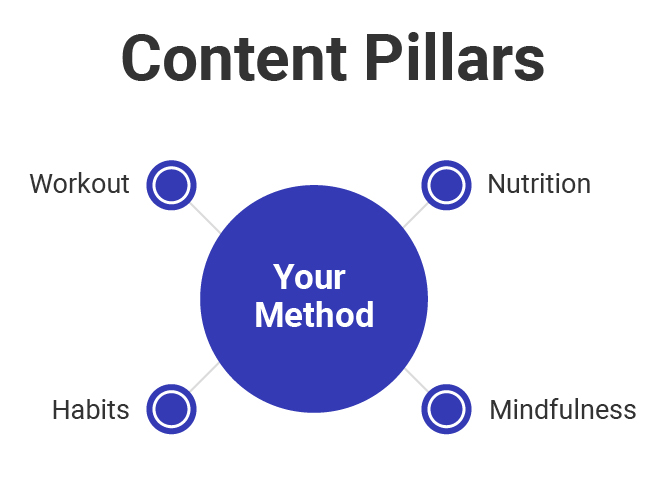
Think about four main components of your method. We call them “your content pillars.” These will be pretty general.
For example:
- Workout
- Nutrition
- Habits
- Mindfulness
Remember to focus on your ideal clients’ goals. The results one client might want is different from another, so you want to think about how your personal training helps your unique clients get their desired results.
Break each topic down further at least 1-2 levels
Now that you have your main pillars, you can break them down even further into subtopics under each category. The subtopics will be a little more specific.
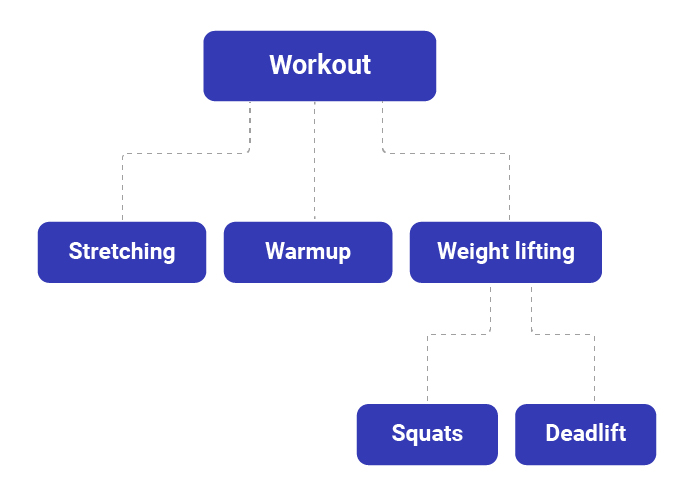
Take a look at these examples:
- Workout
- Stretching
- Warmup
- Weight lifting
- Squats
- Deadlift
- Nutrition
- Meal planning
- Food tracking
- Healthy recipes
- 10 min meals
- Snacks for work
- Filling breakfasts
As you can see, if you do this exercise with your four pillars, you will be left with quite a few subtopics that you can use for your blog. Make sure that the subtopics are in line with your ideal client’s interests and your personal training. From there, we’ll determine how you should approach each topic for your blogs.
Now take the topic and head to Google
Now that you’ve generated some topic ideas, it’s time to nail down how you’ll approach the topic for your blog. As we previously mentioned, you want your blogs to be on topics that people care about, but you also want to make sure that the subject hasn’t already been hammered to death online.
Go to Google and enter your topic. Pay attention to the first results that pop up. If you type in something very general like “how to do squats”, you’ll quickly see how countless other sites have approached the subject. From there, look at the Google suggestions.
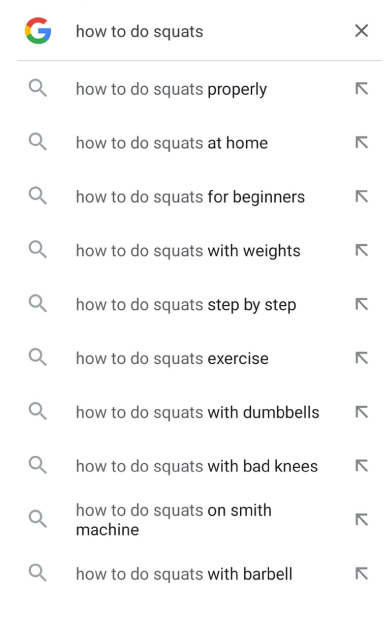
For this particular search, Google suggest things like:
- How to do squats with dumbbells
- What muscles do squats work
- How to do squats at home
Pick a suggestion that you feel is right for your ideal client and you would like to write about. Using Google suggestions can help you get more creative with topics and ensure that you are writing about something people are already asking.
Bonus tool: Try out AnswerThePublic which will give you search insights based on keywords you input. This tool can help you visualize search recommendations and what people are typing into Google. \
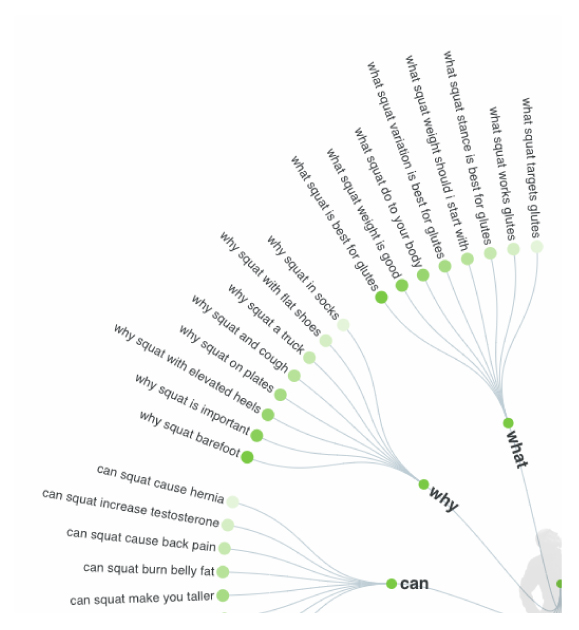
Do keyword research
You can learn a lot about the quality of a topic by playing around on Google. To take your topic testing even further, conduct keyword research to learn more about how many people are using a search term. You can then use that information to know which keywords your blog should include to give you a better chance of showing up in online search results.
Here are the steps of doing keyword research:
- Visit or install a keyword research tool like Keyword Everywhere or SEMrush.
- Use their search feature to type in the topic you want to write about.
- Look at the daily search volume . Ideally, you want this number to be in the hundreds.
- Analyze the current search results. Can you do better?
- Play around with different variations of your key phrase.
- Once you find a winning topic, be sure to save the results where you can review it anytime.
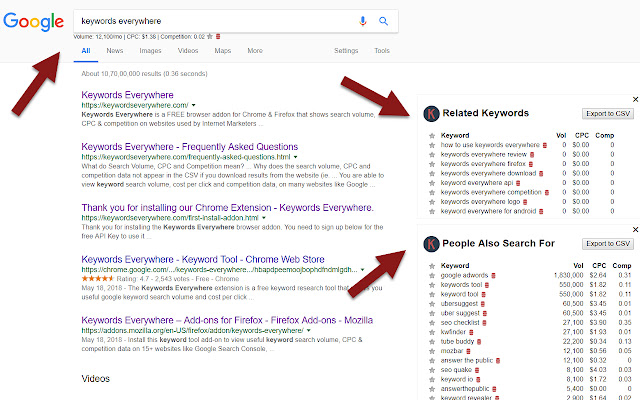
Writing your blogs with keywords in mind will ensure that you are writing about topics that people care about. This is a big part of Search Engine Optimization (SEO) which helps drive traffic to the various pages of your website. To learn more about this, check out our blog on Personal Trainer SEO.
Fitness blog ideas to inspire you
The process above should help you generate topic ideas that are in line with what your ideal client wants to read. However, we all get writer’s block from time to time, so if you need even more fitness blog inspiration, use these examples as a reference.
Remember to tailor all content toward your ideal client and use your own knowledge and industry expertise to provide unique value to your readers.
Exercise blog topics
- Cardio
- At-home workouts
- Exercise equipment how-tos
- Yoga
- Group classes
- HIIT
- Strength training
- Gym tips
Dive deeper on these ideas with the help of Google and a keyword tool. Share everything you know about different exercises including methods, benefits, contraindications, modifications, etc. Think about the questions your clients typically have around these types of things and answer those questions in your blog.
Nutrition blog topics
- Meal prepping
- Your go-to healthy recipes
- Healthy recipes the whole family will love
- Apps for meal tracking
- Meal prepping supplies
- Healthy recipes on a budget
- Protein packed breakfast ideas
This is a topic that people constantly have questions about. Share what you know about nutrition and eating healthy and tailor it to the concerns your clients have.
Habit and mindset topics
- How to incorporate training into your schedule
- Forming new habits
- Staying on track when traveling
- Tips for new moms
- Mental benefits of exercise
- How to make positive change in life
Your topics don’t have to be all about exercise and diet! Personal training involves holding clients accountable, which often entails supporting their fitness journey through habit and mindset coaching. Use your blog to share what you know and inspire your readers.
Your fitness recommendations
- Top 5 fitness podcasts
- Youtube yoga that you love
- Affordable at home equipment
- Best athletic wear brands for women
- Favorite workout playlists
Add some personality and a human element to your blogs by recommending some of your personal fitness favorites. This is helpful content that people love, and helps you build trust and likability with your readers.
Final tips
To come up with fitness blog ideas that make you money, start by thinking about your ideal client. Hash out what problems you solve for them and how to come up with your four main content pillars.
Break those pillars down into subtopics and you’ll have an almost endless list of possible ideas. Run potential topics through a Google search for more inspiration and complete keyword research to determine the typical search volume of any given term.
Feel free to refer back to this blog for inspiration, but always try to put your own spin on every post and highlight your unique experience, knowledge, and industry expertise.
A great fitness blog can help you grow your personal training business to new heights, but it’s just one player in an overall strong marketing strategy. We have a lot of great resources for personal trainers looking to market themselves online. Check them out here:
Frequently Asked Questions
1. Why is it important to come up with creative fitness blog ideas?
Creative and engaging blog topics help attract and retain readers, improve website traffic, and establish your authority in the fitness niche. Unique ideas tailored to your audience’s needs can also increase sharing and engagement.
2. How do I define my target audience for a fitness blog?
Start by identifying who your content is for. Consider their fitness goals, age, challenges, and interests. For instance, are they beginners, athletes, or people trying to lose weight? Understanding this helps in tailoring content effectively.
3. What are content pillars, and how do they help in planning blog topics?
Content pillars are key themes or categories that represent your fitness expertise. They provide structure to your blog, ensuring diverse yet cohesive topics. Common fitness pillars include:
- Workouts
- Nutrition
- Fitness Technology
- Lifestyle and Habits
4. How can I use my content pillars to generate specific blog topics?
Break down each pillar into focused subtopics. For example:
- Workouts: “The Best Home Workouts for Beginners”
- Nutrition: “5 Protein-Rich Meals for Muscle Gain”
- Lifestyle: “How to Stay Motivated to Work Out During Winter”
5. How do I ensure my fitness blog ideas are SEO-friendly?
Perform keyword research to understand what your target audience is searching for. Focus on long-tail keywords and optimize your blogs by including these in titles, subheadings, and content.
Ultimate Guide to Instagram Marketing for Personal Trainers
Personal Trainer Email Marketing: The Definitive Guide
[Personal Trainer Marketing: How to Get More Clients Fast in 2025 (https://www.trainerfu.com/blog/how-to-get-more-online-personal-training-clients/)